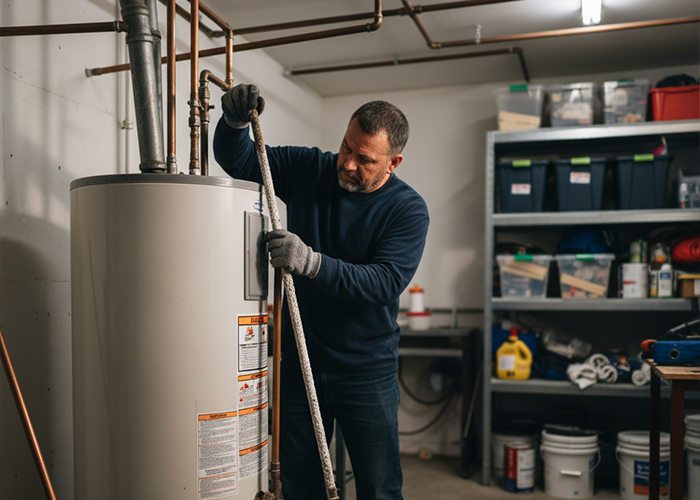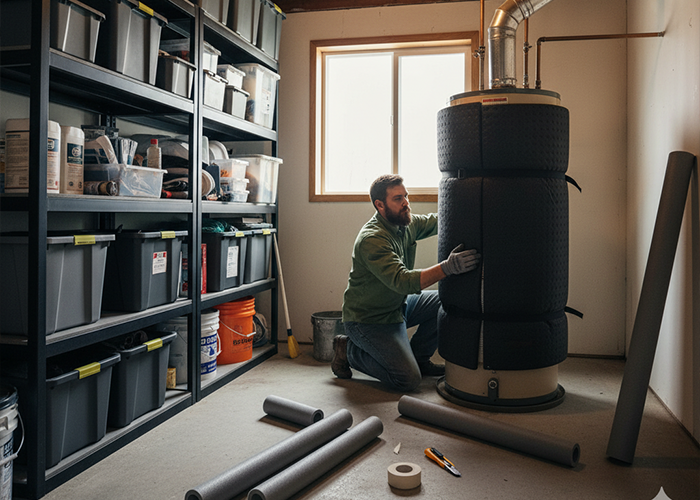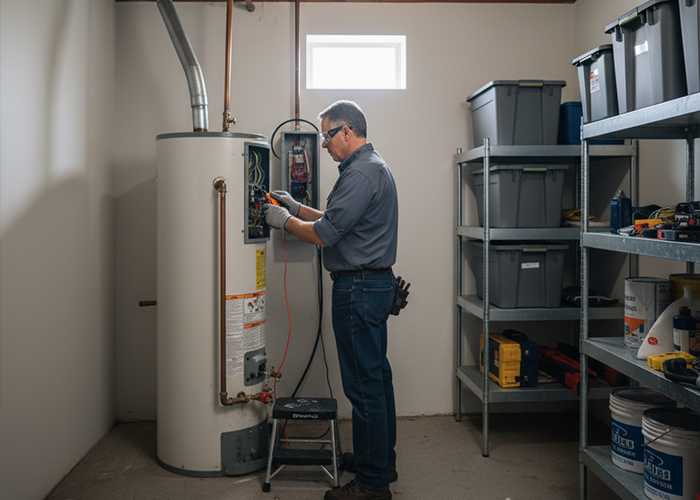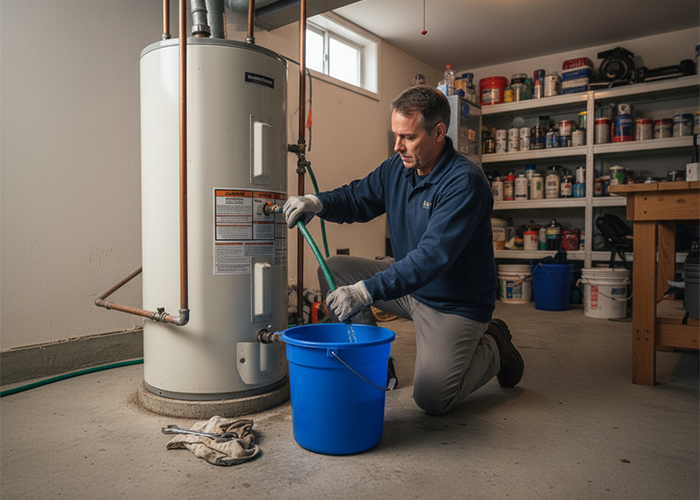A steady stream of hot water feels routine until it is not. With simple water heater maintenance, you can prevent cold showers, messy leaks, and surprise costs. A few small habits keep your system safe, efficient, and ready when you need it.
Why Water Heater Maintenance Matters
Think of your water heater like a quiet workhorse. It runs every day, even when no one is watching. Regular water heater maintenance keeps energy use in check and helps the tank last longer, which saves money over time.
Small checks add up. A quick look at the temperature setting, a short test of one safety valve, and a brief flush can make a big difference. Most of these tasks take minutes, not hours.
Know Your Home Water Heater

Start by confirming the type and age of your unit. Most homes use either a standard tank unit, gas or electric, or a tankless model. The rating plate on the side shows the model, serial number, fuel type, and year made.
It also helps to find the shutoff controls. Know where the cold-water supply valve is. Learn where to turn off gas or power in case you ever need fast action.
Set a Safe Temperature
A good target is about 120 degrees Fahrenheit. This helps prevent scalds and keeps bills lower. Many units ship at higher temps, so it is wise to check.
If your dishwasher needs hotter water, use the appliance’s boost setting if it has one. That way, the whole house does not run hotter than needed.
Test the Temperature and Pressure Relief Valve

The T and P relief valve is a key safety part. It opens if pressure or temperature gets too high. Place a bucket under the discharge pipe, lift the test lever for a moment, then let it snap back.
Water should flow, then stop. If it drips constantly or does nothing, the valve should be replaced by a pro. Testing once a year is smart.
Flush Sediment to Keep Performance Steady
Mineral buildup makes heaters work harder. A quick partial drain helps remove sediment from the bottom of the tank. Turn off the power or set the gas control to vacation first, then close the cold-water supply and connect a hose to the drain valve.
Open a hot tap in the house so air can enter, then drain a few gallons until the water runs clearer. Finish by closing the valve, turning the cold supply back on, and restoring power or gas. A full flush may be recommended if the water is very hard.
Check the Anode Rod for Corrosion

The anode rod helps protect the tank from rust. It is a long metal rod threaded into the top of the unit. If most of the rod has worn away or it is coated with calcium, it is time to swap it out.
This job can be done by experienced homeowners, but many prefer to have a technician handle it. A fresh anode rod can extend tank life in a big way.
Look at the Expansion Tank
Many closed plumbing systems include a small expansion tank near the heater. It absorbs pressure changes as water heats and cools. If that tank fails, pressure swings can stress pipes and valves.
Tap it lightly. The top should sound hollow, and the bottom should sound full. If it feels heavy all the way or waterlogged, call a pro to check it.
Insulate the Tank and Hot Water Pipes

Insulating hot water pipes reduces heat loss from your taps. Short pipe runs near the heater give the best return. Pre-slit foam sleeves are easy to add.
If your tank is warm to the touch, a jacket can help. Follow the manufacturer’s rules, and never cover controls, vents, or the top of a gas unit. Pipe insulation is a safer first step for most homes.
Give Gas Units Special Attention
For gas heaters, look at the flame. It should be steady and mostly blue. A yellow, flickering flame can mean trouble with combustion.
Make sure the draft hood and vent are secure and clear. If you ever smell gas, shut things off and call for help right away.
Care for Electric Units

Electric models use heating elements inside the tank. If hot water runs out fast or recovery is slow, a bad element or thermostat may be the reason. A technician can test and replace parts safely.
Turning off the power at the breaker is essential before any work is done. Electricity and water do not mix.
Keep Clearance and Venting in Mind
Heaters need space to breathe and to be serviced. The area around the unit should be clear of boxes, paint cans, and clutter. Good airflow helps gas units vent properly and reduces fire risk.
Look at the vent path for kinks or blockages. Birds’ nests and debris can cause problems in some homes.
Spot Signs of Trouble Early
Catch small issues before they grow. Scan the floor for puddles or rust trails. Listen for popping or rumbling sounds from the tank.
Here are quick red flags to watch for:
- Water on the floor or rust at fittings
- Hot water that runs out much faster than usual
- New noises during heating
- A pilot that will not stay lit or a breaker that keeps tripping
When to Call for Water Heater Repairs
Some fixes are not DIY. If the T and P valve will not seal, if the burner misfires, or if the tank itself leaks, professional water heater repairs are the right move. A tank leak usually means replacement is due.
Call sooner rather than later. Fast attention can prevent water damage and keep you safe.
Create a Maintenance Schedule
Create a routine you can keep. Every month or two, look for leaks and confirm the temperature setting. Twice a year, do a short sediment drain and test the T and P valve.
Once a year, check the anode rod and expansion tank. If the water is very hard, consider doing a more thorough flush. This rhythm keeps water heater maintenance light and consistent.
Seasonal Checks that Pay Off
At the start of the cooling season, confirm your tank’s temperature as the cold water supply changes. In fall, clear the area around the heater before holiday cooking and guests. Winter is a good time to wrap exposed hot water pipes in chilly spaces.
Spring is perfect for a fresh flush. This cadence keeps the system steady across the year.
Small Upgrades that Boost Efficiency
A few add-ons can help. Low-flow showerheads reduce hot water demand without a harsh feel. Heat traps or built-in check valves keep heat in the tank.
Smart leak sensors placed near the base of the unit can send alerts to your phone. This simple tech can save a floor from damage.
Safety Notes and Local Codes
Safety comes first. The discharge pipe from the T and P valve should terminate close to the floor. It should never be capped or reduced in size.
Local plumbing codes may set rules for strapping, pans, drain lines, and venting. If you are unsure, ask a licensed plumber to review your setup.
Travel Tip: Vacation Settings and Shutdowns
Going away for a week or two? Set a gas unit to vacation. For electric units, switch off the breaker if your manual allows it, then turn it back on when you return.
If freezing is a risk, do not shut off the heat to the space around the heater. Burst pipes cost far more than a few dollars in energy.
Hard Water and What You Can Do
Hard water speeds up sediment buildup. If you see white scale on faucets, your tank is likely dealing with the same minerals. More frequent flushes can help.
Some homes add a water softener. If you go that route, ask about the right anode rod type, since soft water can change corrosion patterns.
Tankless Systems Need Care too
Tankless heaters do not store water, but they still need service. Annual descaling is common in hard water areas. Air intakes and vents should stay clear.
If the output temperature swings, a filter may be clogged or the flow sensor may need cleaning. A trained technician can handle this during a routine visit.
Keep Combustibles away from the Heater
Paint thinners, gasoline, and cleaners should be stored far from the unit. Even cardboard boxes can be a risk when placed close to gas heaters. A clear zone protects your home.
This also gives a technician room to work. Service goes faster when the area is open and tidy.
Know When Replacement Makes Sense
Most tank units last 8 to 12 years, sometimes longer with good care. If your unit is near the end of that range and repairs start to add up, replacement can be the smart choice. New models use less energy and recover faster.
Ask about size, fuel type, recovery time, and warranty. A properly sized unit is key to comfort and cost control.
Warranties and Manuals
Keep the manual and warranty in a safe spot. Many brands post digital copies by model number. The manual lists the tasks the maker expects, plus the parts that are covered.
Following that plan helps if you ever need warranty service. It also keeps your water heater maintenance aligned with the people who built the unit.
Keeping Your Water Heater in Check
A little time on water heater maintenance pays you back with steady hot water, lower bills, and fewer surprises. Start with the basics, then add one or two upgrades as you go. If something looks off, call for water heater repairs before a small issue grows.
Related Articles:
- Why Is Efficient Drainage In Commercial Facilities Vital For Proper Water Flow?
- How To Remove Water Spots From Windows
- Commercial Handrail Repair And Maintenance

